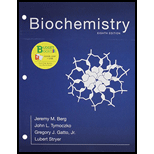
Concept explainers
Interpretation: The score for the given alignment is to be calculated using the identity-based scoring system. Also, whether the given proteins are related to each other or not is to be identified.
Concept introduction: Proteins are the
Answer to Problem 1P
The score for the given alignment is
Explanation of Solution
The given alignments of proteins are shown below.
In the above alignments, there are
Hence, the score for the given alignment is
The above two sequences has
Want to see more full solutions like this?
Chapter 6 Solutions
Loose-leaf Version for Biochemistry
- DO NOT COPY OLDER ANSWERS! AND SHOW FULL WORK! I have a mixture of 4 proteins, whose sequences are shown below (note that each protein is a 100-repeat of the sequence shown). Protein A: (Gly-Ala-Lys-Val-Ile-Phe-Glu-Val-Asn-Gly) Protein B: (Ala-Ala-Lys-Arg-Ile-His-Glu-Ala-Asn-Lys) Protein C: (Glu-Val-His-Asp-Ala-Asp-Glu-Val-Asn-Asp) Protein D: (Ala-Lys-Arg-Phe-Trp-Phe-Gly-Ile-Ala-Gly) 1) Which protein/s are MOST LIKELY to precipitate out at a pH of 3.5? a) A b) B c) C d) D e) B & C f) A & D g) None of them h) Cannot be determined.arrow_forwardusing, 3’ TGAGGCGCTAGGCCAAGCGGTAAGGATGCATGGTCGTGGTAG , What would be the resultant type of error on the amino acid chain?arrow_forwardHow to calculate the molecular weight of the given protein sequence; NH3+GLN-ALA-CYS-GLN-GLN-IIE-COOHarrow_forward
- We need a string-matching-based approach to identifying protein homologies between several proteins. In what way does it function? With what evidence do you back up your assertion?arrow_forwardPls help ASAP, thank you! "An alpha-helical structure within a protein is stabilized mostly by"arrow_forwardReferring back to the quaternary level proteins, list and describe the modifications that can be made to a secondary proteins to make it a tertiary proteinarrow_forward
- GABA (B) protein Need help answering questions about the GABA(B) protein. What is the primary structure Describe secondary structure (alpha-helix, beta sheet, and how many of each and what percent of the total protein)What is the tertiary structure (which should also show secondary structure)Does the protein have a quaternary structure, if so what is it?arrow_forwardAnswer for each 1, 2, 3, 4 and 5 labelled in the attached image: a)What is this molecule? b)What superfamily does it belong to? c)Which number points to the peptide binding domain? Thank you!arrow_forwardLeu-Trp-Phe-Met-Ala-Ile-Val- Draw the structure of the peptide at pH7.4. and Indicate the hydrogen bonds formed in the alpha helix.arrow_forward
- Question- Determine the exact molecular weight of the following oligonucleotide and calculate the average molecular weight of an equivalently long oligonucleotide. What is the percent error between the two? Sequence (5’-3’) : GCT TTA GCG GTC AAG TGC TGT GCC ATT T M.W. of a nucleotide in ssDNA = 303.7 + 79.0 M.W. of base pair in dsDNA = 607.4 + 158arrow_forward1) In MALDI-TOF data, when performing peptide mass mapping search, a) The number of peptides matched decreases from 13 to 11 and the sequence coverage decreases to 47%, but the protein score increases from 111 to 124. Explain. b) The nnumber of 11 peptide masses matched and the sequence coverage is 47% (same as in part a), but the protein score increases to 157. Explain.arrow_forward1. Where’s Elvis? Translate the following amino acid sequence into one – letter code: Glu – Leu – Val – Ile –Ser – Ile – Ser – Leu – Ile – Val – Ile – Asn – Gly – Ile – Asn – Leu – Ala – Ser – Val – Glu – Gly – Ala – Ser.___ ___ ___ ___ ___ ___ ___ ___ ___ ___ ___ ___ ___ ___ ___ ___ ___ ___ ___ ___ ___ ___ ___arrow_forward
 BiochemistryBiochemistryISBN:9781305961135Author:Mary K. Campbell, Shawn O. Farrell, Owen M. McDougalPublisher:Cengage Learning
BiochemistryBiochemistryISBN:9781305961135Author:Mary K. Campbell, Shawn O. Farrell, Owen M. McDougalPublisher:Cengage Learning
